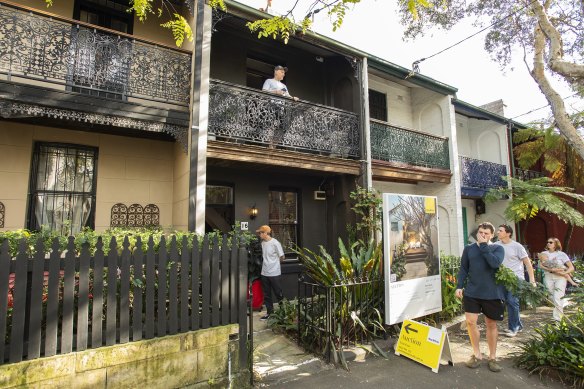This was published 5 months ago
How - and why - it just got even harder to buy a home in Australia
By Jim Malo and Tawar Razaghi
Would-be home buyers have been hit by a lose-lose situation of falling borrowing capacity and property prices that have not followed suit, making housing affordability worse.
Modest declines in median house values in cities such as Melbourne have been outpaced by cratering borrowing capacities, experts say, while Sydney’s median house value is now higher than when interest rates began rising.

Home values have not matched the falls in borrowing capacity.Credit: Steven Siewert
A household earning twice the average income has had their borrowing capacity slashed by $307,000 since the Reserve Bank began hiking rates in May 2022 – a 24 per cent decrease, Canstar modelling shows. A single’s borrowing capacity also fell 24 per cent, by $132,000.
There are no capital cities where house prices have fallen by close to 24 per cent. Hobart, the deepest drop, was down 13.1 per cent. Melbourne fell 7.2 per cent and Sydney’s median house value is 4.4 per cent higher than pre-rate hikes.
A dual-income household could borrow a maximum $1,271,000 in April 2022, Canstar estimates show. Now, they could borrow about $964,000 to add to their deposit despite modest growth in wages over the period. A single could borrow only $421,000.
Interest rate rises had the biggest effect on borrowing capacity; 13 hikes brought the cash rate from its record low of 0.1 per cent to 4.35 per cent, where it was held again on Tuesday.
Canstar data insights director Sally Tindall said borrowing capacities had been “shredded” by the hikes, which had in turn made it harder to buy Australia’s already unaffordable property.
“For property hotspots, largely Sydney, prices have broadly stayed the same when you compare pre-hike prices to today,” she said. “Yet someone’s borrowing capacity has gone through the shredder.
“Melbourne is one of the cities where prices have actually dropped, but not in line with capacity.”
Buyers hoping to buy into previously affordable markets such as Brisbane, Adelaide and Perth would have to contend with higher median values than Melbourne, Tindall said.
“It’s not surprising to see the capital cities that originally had lower price tags go through significant growth where the supply and demand equation doesn’t stack up,” she said. “Borrowers there weren’t borrowing at maximum capacity so they were less encumbered by rate hikes.”
AMP Capital chief economist Dr Shane Oliver said house prices were about 26 per cent higher than they should be, based on the assumption prices were tied to borrowing capacities. At its peak, the gap was about 29 per cent, he said.
“There has been some improvement in households’ capacity to pay because interest rates have been on hold over the last year now and incomes have gone up a little bit, but we’re still in a situation where the gap is wide and that hasn’t changed.”
CBA’s head of Australian economist Gareth Aird said buyers needed larger deposits and had to pay higher repayments because of the mismatch between house prices and borrowing capacities.

Slashed borrowing capacities are causing buyers to reconsider entering the property market. Credit: Dion Georgopoulos
”From the perspective of a first home buyer trying to enter the market it’s harder now than it was a few years ago. It’s very tough,” he said, adding that many were turning to the bank of mum and dad as a result. Experts believe the transfer of intergenerational wealth to buy property was contributing to the decoupling of house prices and borrowing capacities.
Equilibria Finance founder and broker Anthony Landahl said the double whammy of rising mortgage rates and property prices had changed buyer behaviour while others had put off buying a home altogether.
“Buyers are changing the type of property they are able to purchase; they’re looking at a townhouse or a unit instead of a house,” Landahl said.
He said that buyers were struggling to both enter the market and upgrade.
“Buyers might be looking at different areas, they might be trying to upgrade from a unit to a house and the gap is too big in terms of prices, so they have to look three, or four, or five suburbs away or even further away,” he said.
“The price gap between houses and units has really widened and that’s making the challenge of upgrading in the same area even more difficult.”
Oliver said it wasn’t a sure bet house prices would run away again once rates were cut because it was unlikely they would return to ultra-low levels seen since the GFC and buyers would no longer have access to cheap debt.
“If, say, the RBA just cuts the cash rate four times and go to 3.35 per cent … that’s still higher than where it was … the capacity to pay won’t be as high as it was in 2021.
“We may get a situation where one of the biggest drivers of property prices over the last 30 years is no longer a factor,” he said. “It’s lucky country stuff.”